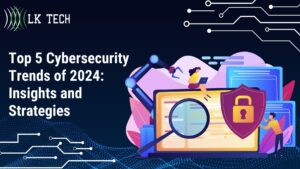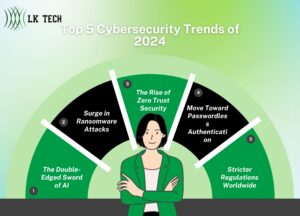The Evolving Cyber Threat Landscape: A Look at the Top 5 Cybersecurity Trends of 2024
As we enter the second quarter of 2024, the cybersecurity landscape is undergoing a fundamental transformation. The combined forces of artificial intelligence (AI) and escalating tactics on the dark web are ushering in a new era of cyber threats. These constantly adapting attacks are outpacing traditional security measures, forcing organizations to reassess their defense strategies.

- Top 5 Cybersecurity Trends of 2024: Insights and Strategies
This article explores the top five cybersecurity trends that are redefining the landscape in 2024. By understanding these emerging threats, business leaders can take proactive steps to safeguard their organizations. Insights are drawn from cybersecurity experts at CBIZ, a professional services firm providing financial, advisory, and consulting solutions.
The cybersecurity field is advancing at breakneck speed, with new innovations emerging daily. However, as technology evolves, so do the tactics of cybercriminals. Businesses must stay vigilant, implementing layered defenses and continually monitoring threats. With the right strategies, organizations can get ahead of attackers and minimize disruptions. But neglecting cybersecurity puts operations, finances, and reputations at grave risk.
The Double-Edged Sword of AI
The first major trend is the growing use of AI by both cybersecurity professionals and hackers:
- On one hand, AI tools are revolutionizing cybersecurity defenses. Solutions now actively incorporate AI to predict attacks by analyzing historical data and current trends. This allows for more proactive threat identification and mitigation.
- For example, advanced AI systems can detect anomalies and suspicious behaviors that signal an impending attack. By flagging these early warning signs, organizations gain valuable time to shore up defenses.
- AI also enables predictive analytics to forecast the types of threats a business is likely to face based on factors like industry, size, geographic location, and more. This allows security teams to proactively hunt for vulnerabilities and get ahead of potential attacks.
- However, AI is also being used by criminals to create more advanced and convincing scams. Tactics include:
- Self-evolving malware that mutates to evade detection
- Deepfake video/audio that impersonates executives and employees with stunning realism, tricking victims into transferring funds or disclosing sensitive data
- QR code manipulation where fake codes send users to phishing sites to harvest login credentials
- Chatbot infiltration that allows hackers to impersonate customer service bots and steal data
- AI writing tools that generate persuasive phishing emails tailored to individual targets
- As AI becomes more powerful and accessible, cybercriminals are exploiting it to amplify social engineering through tactics like smishing and chatbot hijacking. Deepfakes in particular are extremely difficult to detect even by trained professionals. As AI technology spreads, the sophistication and impact of these scams will likely escalate.
Surge in Ransomware Attacks
Another worrying trend is the proliferation of ransomware attacks:
- The emergence of Ransomware-as-a-Service and Phishing-as-a-Service allows even amateur hackers to easily launch attacks. This explains the recent surge in ransomware incidents, with tactics becoming more aggressive.
- For example, double extortion tactics are on the rise where data is not just encrypted but also stolen and threatened for exposure. This additional blackmail leverage makes victims more likely to pay.
- Ransom demands are skyrocketing, with average payouts now in the millions. The highest reported ransom to date is $50 million paid by an electronics manufacturer in 2022.
- Many organizations feel they have no choice but to pay, fearing business collapse if operations remain halted. But rewards only incentivize more attacks.
- Zero-day vulnerabilities are a key enabler, providing no time to address newfound software/hardware flaws before criminals exploit them.
- Robust backup strategies, employee training, and incident response plans are crucial to minimize ransomware damage. Many organizations are also seeking cyber insurance and specialized security services.
The Rise of Zero Trust Security
Given escalating threats and remote work shifts, organizations are adopting zero trust models:
- This assumes no implicit trust based on network location. Rigorous identity and device verification is required for all users and endpoints attempting to access resources.
- Multi-factor authentication, IP whitelisting, micro-segmentation, and encryption are common zero trust strategies.
- Granular access controls mitigate breach impact by granting minimal permissions to users and devices. This contains damage by preventing lateral movement across systems.
- As part of this shift, Chief Information Security Officers (CISOs) now play a bigger role in cyber strategy and policy enforcement. They lead the charge in implementing zero trust frameworks.
- While not flawless, zero trust principles allow organizations to significantly reduce their attack surface and minimize risks. NIST estimates that over 80% of breaches involve compromised credentials — zero trust directly addresses this root cause.

- Top 5 Cybersecurity Trends of 2024: Insights and Strategies
The Move Toward Passwordless Authentication
Reliance on passwords has spawned massive stolen credential markets:
- Weak and reused passwords remain one of the top attack vectors. They allow effortless access once compromised.
- Consequently, stronger verification methods like biometrics, hardware tokens, and public-key cryptography are gaining momentum.
- Fingerprint, facial recognition, iris scans, and voice matching offer convenient passwordless access. Security keys and apps provide robust second factors. And public-key systems use encryption to secure credentials.
- These solutions offer enhanced defense against cyberattacks, insider threats, and fraud by eliminating static passwords. Expect exponential growth as technology and adoption improves.
Stricter Regulations Worldwide
Finally, governments worldwide are imposing stricter cybersecurity regulations:
- In the US, public firms must now report breaches within four days of discovery. Annual disclosures on cyber risk strategy are also mandated.
- The EU has enacted laws like GDPR that levy steep fines for inadequate controls. Breaches affecting personal data can draw penalties upwards of 4% of global revenue.
- Similar regulations are emerging in Canada, UK, Australia, and across the APAC region, spurred by major attacks.
- As threats evolve, particularly AI-powered attacks, tighter oversight is expected globally. Forthcoming laws will likely increase liability for lax security and mandate specific controls.
- While compliance costs worry some businesses, stringent policies aim to increase baseline security and resilience across sectors. They provide a framework to follow as threats accelerate.
Final Thoughts
Vigilance is mandatory in today's cyber landscape. Regular training, robust security tools, and updated defenses are essential. For guidance tailored to your organization's needs, leverage cybersecurity experts like those at CBIZ. Our services span consulting, assessments, risk management, compliance, and more. Let us help you navigate the cybersecurity trends of 2024 and fortify your defenses.
With cybercrime damages projected to hit $10.5 trillion annually by 2025, no organization can afford inaction. Use this article's insights to inform strategic decisions and security investments. Prioritize measures like zero trust, multifactor authentication, backup systems, and employee education to protect your organization. Monitor industry threats, regulations, and technologies to adapt your defenses over time. With a proactive approach, businesses can stay resilient even as the cyber risk climate deteriorates. Reach out to a trusted cybersecurity partner like CBIZ for ongoing guidance.
In LK Tech, an IT services company based in Cincinnati, Ohio, we provide innovative solutions tailored to your unique logistics needs. Our team delivers top-notch service and expertise to help you stay ahead in the industry. Contact us today to find out how.

